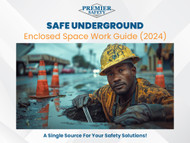Safe Underground: Enclosed Space Work Guide (2024)
Posted by Michael Womack - Premier Safety on Jul 11th 2024

The world beneath our feet holds vital infrastructure for our daily lives. From manufacturing plants to utility networks, safe and efficient underground work is crucial. However, these environments often feature enclosed spaces – confined areas that can pose serious safety hazards to workers.
This guide by Premier Safety delves into essential safety practices for enclosed spaces in underground work. We want to give you the information you need to stay safe while working underground. This information includes following OSHA rules. It involves knowing how to enter the area, managing risks, and what to do in an emergency.
What are Enclosed Spaces?
Enclosed spaces are defined as work areas that may have:
Limited or restricted means for entry and exit.
Internal atmospheres that can be different from the surrounding environment.
The potential for engulfment by a liquid or granular material.
These spaces do not support continuous occupancy and can breed various hazards.
Types of Enclosed Spaces
Underground work environments can involve a variety of enclosed spaces:
Manholes: These access points to underground utility lines are common in urban settings and pose atmospheric and engulfment hazards.
Vaults: are spacious enclosed areas for electrical equipment and utilities. They can trap gases and lack ventilation, making them dangerous.
Other Enclosed Underground Spaces: like tunnels, storage tanks, and crawl spaces need to follow safety protocols.
Enclosed Spaces: Pre-Entry Protocols
Safety First: Before any worker enters an enclosed space, thorough preparation is paramount. Here are key protocols to follow:
Pre-Entry Safety Assessment: Before entering a small space, someone trained must check for harmful gases and substances in the air.
Equipment and Personnel Requirements: The assessment will determine the equipment needed for safe entry, such as lighting, ventilation, respirators, and communication devices. Additionally, we must station someone qualified outside the space to monitor and respond to emergencies.
Safe Work Practices in Enclosed Spaces
Once entry is authorized, safe work practices are crucial:
Entry and Exit Protocols: Follow the rules for entering and exiting to make sure you pass through access points safely and in a controlled way.
Working Alone Safely: Never enter an enclosed space alone. Always have a trained attendant monitoring the situation from outside.
Hazard Control in Enclosed Workspaces
Underground enclosed spaces can harbor a multitude of hazards:
Electrical Safety Measures: Identify and de-energize electrical equipment before entry. Utilize proper electrical safety gear and maintain a safe distance from live wires.
Atmospheric Hazards: Utilize portable and fixed gas detectors to continuously monitor the atmosphere for oxygen deficiency, flammable gases, and toxic substances. If necessary, implement confined space ventilation to maintain a safe breathable environment.
Emergency and Rescue Procedures
Planning for emergencies is vital in enclosed spaces:
Planning for Emergencies: Develop a comprehensive emergency action plan outlining rescue procedures and communication protocols in case of an accident or worker incapacitation.
Flame Use and Equipment Lowering: Never use open flames or spark-generating equipment within the enclosed space. Utilize proper lowering methods for tools and equipment to avoid creating additional hazards.
OSHA Regulations for Enclosed Spaces
The Occupational Safety and Health Administration (OSHA) has established strict regulations (29 CFR 1910.146) governing enclosed space entry. Familiarize yourself and your crew with these regulations to ensure compliance.
Best Practices for Working in Enclosed Spaces and Underground
Here are some additional best practices to prioritize safety:
- Regularly check and maintain equipment used for entering enclosed spaces, like winches and harnesses, to ensure safety.
- Train employees on confined space safety to ensure they know the risks, procedures, and emergency plans. For their safety, it is important.
- Consider using air sampling services to analyze the air in a space before entering.
FAQs: Enclosed Spaces Demystified
What is an Enclosed Environment?
An enclosed environment is a space with few openings and may have a different atmosphere than the surrounding area.
What is an Enclosed Space Vs an Open Space?
Open spaces have easy access and egress points and typically share the same atmosphere as the surrounding environment. Enclosed spaces are more restricted and can have unique atmospheric conditions.
What's the Difference Between Enclosed Space and Confined Space?
People often use "confined space" interchangeably with "enclosed space." However, some definitions differentiate confined spaces by adding the element of restricted movement within the space.
What Are the Key Characteristics?
The key features are:
Limited entry/exit points
Potential for a different atmosphere than the surrounding area
Risk of engulfment by liquids or granular materials
Is a Confined Space Fully Enclosed?
Not necessarily. Some confined spaces are fully enclosed. Others have open tops but limited access because of their size, shape, or hazardous atmosphere.
Empowering Safe Underground Work: Your Partner in Enclosed Space Safety
Working in confined spaces can be complex, but prioritizing safety practices and adhering to regulations can significantly reduce risks. Premier Safety offers a comprehensive selection of confined space equipment, including confined space lighting, ventilation, winches, and respirators. We also provide training resources and support to help you establish a robust confined space safety program.
Remember, prioritizing safety is an investment in your workforce and the foundation for successful underground operations. Contact Premier Safety today to discuss your specific enclosed space safety needs and explore our solutions.

